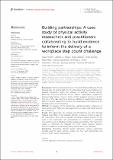Files in this item
Building partnerships : a case study of physical activity researchers and practitioners collaborating to build evidence to inform the delivery of a workplace step count challenge
Item metadata
| dc.contributor.author | Niven, Ailsa | |
| dc.contributor.author | Ainge, James A. | |
| dc.contributor.author | Allison, Mary | |
| dc.contributor.author | Gorely, Trish | |
| dc.contributor.author | Kelly, Paul | |
| dc.contributor.author | Ozakinci, Gozde | |
| dc.contributor.author | Ryde, Gemma C. | |
| dc.contributor.author | Tomaz, Simone A. | |
| dc.contributor.author | Warne, Samuel | |
| dc.contributor.author | Whiteford, Victoria | |
| dc.contributor.author | Greenwood, Carl | |
| dc.date.accessioned | 2023-01-20T17:30:07Z | |
| dc.date.available | 2023-01-20T17:30:07Z | |
| dc.date.issued | 2023-01-04 | |
| dc.identifier | 283034781 | |
| dc.identifier | 508ca7dd-4b7a-49aa-a387-dfb0dde2846e | |
| dc.identifier | 000914809400001 | |
| dc.identifier | 85146468479 | |
| dc.identifier.citation | Niven , A , Ainge , J A , Allison , M , Gorely , T , Kelly , P , Ozakinci , G , Ryde , G C , Tomaz , S A , Warne , S , Whiteford , V & Greenwood , C 2023 , ' Building partnerships : a case study of physical activity researchers and practitioners collaborating to build evidence to inform the delivery of a workplace step count challenge ' , Frontiers in Sports and Active living , vol. 4 , 1067127 . https://doi.org/10.3389/fspor.2022.1067127 | en |
| dc.identifier.issn | 2624-9367 | |
| dc.identifier.other | Jisc: 845118 | |
| dc.identifier.other | ORCID: /0000-0002-2456-5896/work/127065400 | |
| dc.identifier.other | ORCID: /0000-0002-0007-1533/work/127065485 | |
| dc.identifier.other | ORCID: /0000-0001-5869-3274/work/127065896 | |
| dc.identifier.uri | https://hdl.handle.net/10023/26805 | |
| dc.description | Funding: MA and SW have both received ESRC SGSSS PhD Collaborative studentships, where additional funding has been provided by Paths for All. AN has been funded by an University of Edinburgh CAHSS Knowledge Exchange grant. | en |
| dc.description.abstract | Background : Walking is an integral part of Scotland's National Physical Activity Strategy, and the charity Paths for All's Workplace Step Count Challenge is a flagship programme within this strategy to promote physical activity. Effectively promoting physical activity requires collaborative engagement between stakeholders. However, there is limited guidance on how to do this. The aim of this case study is to share an example of a partnership between Paths for All and researchers to inform the development and delivery of the Workplace Step Count Challenge. Method : An overview of the partnership, example activities, reflections on opportunities and challenges, and suggestions for future partnership working are considered. Results : The partnership has evolved and strengthened over time through building trust. Many of the research activities provide an evidence base for the intervention. This work is mutually beneficial providing support for the work of the organisation, and opportunities for researchers to undertake “real world” research, leading to formal outputs and funding. The “real world” nature is challenging to integrate the most robust research designs. Recommendations for developing future partnerships were identified. Conclusion : Promoting physical activity effectively requires partnership working, and this paper provides insight into how such partnerships can work to inform future collaborations. | |
| dc.format.extent | 8 | |
| dc.format.extent | 2651031 | |
| dc.language.iso | eng | |
| dc.relation.ispartof | Frontiers in Sports and Active living | en |
| dc.subject | Sports and Active Living | en |
| dc.subject | Worksite | en |
| dc.subject | Evaluation | en |
| dc.subject | Intervention | en |
| dc.subject | Scotland | en |
| dc.subject | Collaboration | en |
| dc.subject | BF Psychology | en |
| dc.subject | NDAS | en |
| dc.subject | MCC | en |
| dc.subject.lcc | BF | en |
| dc.title | Building partnerships : a case study of physical activity researchers and practitioners collaborating to build evidence to inform the delivery of a workplace step count challenge | en |
| dc.type | Journal article | en |
| dc.contributor.institution | University of St Andrews. Organic Semiconductor Centre | en |
| dc.contributor.institution | University of St Andrews. School of Psychology and Neuroscience | en |
| dc.contributor.institution | University of St Andrews. Institute of Behavioural and Neural Sciences | en |
| dc.contributor.institution | University of St Andrews. School of Medicine | en |
| dc.contributor.institution | University of St Andrews. St Andrews Sustainability Institute | en |
| dc.contributor.institution | University of St Andrews. Population and Behavioural Science Division | en |
| dc.identifier.doi | https://doi.org/10.3389/fspor.2022.1067127 | |
| dc.description.status | Peer reviewed | en |
This item appears in the following Collection(s)
Items in the St Andrews Research Repository are protected by copyright, with all rights reserved, unless otherwise indicated.

